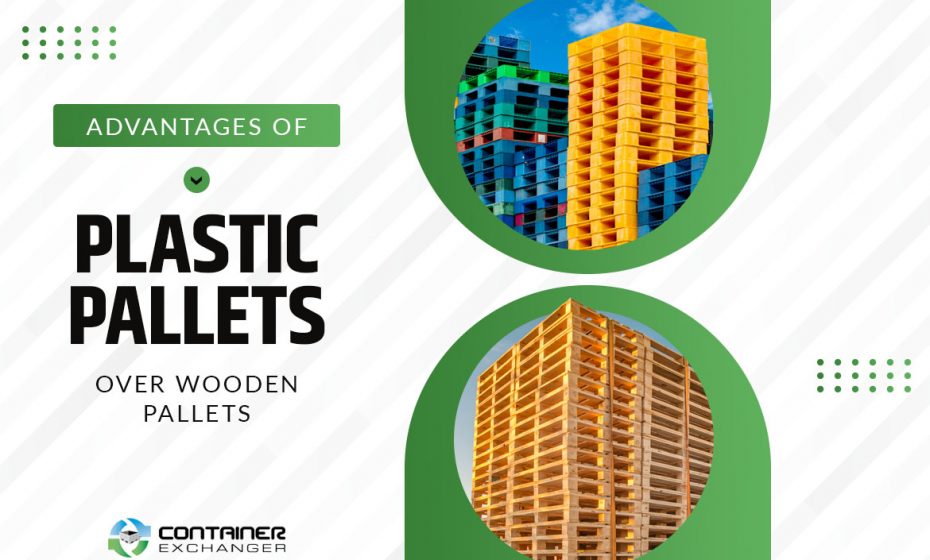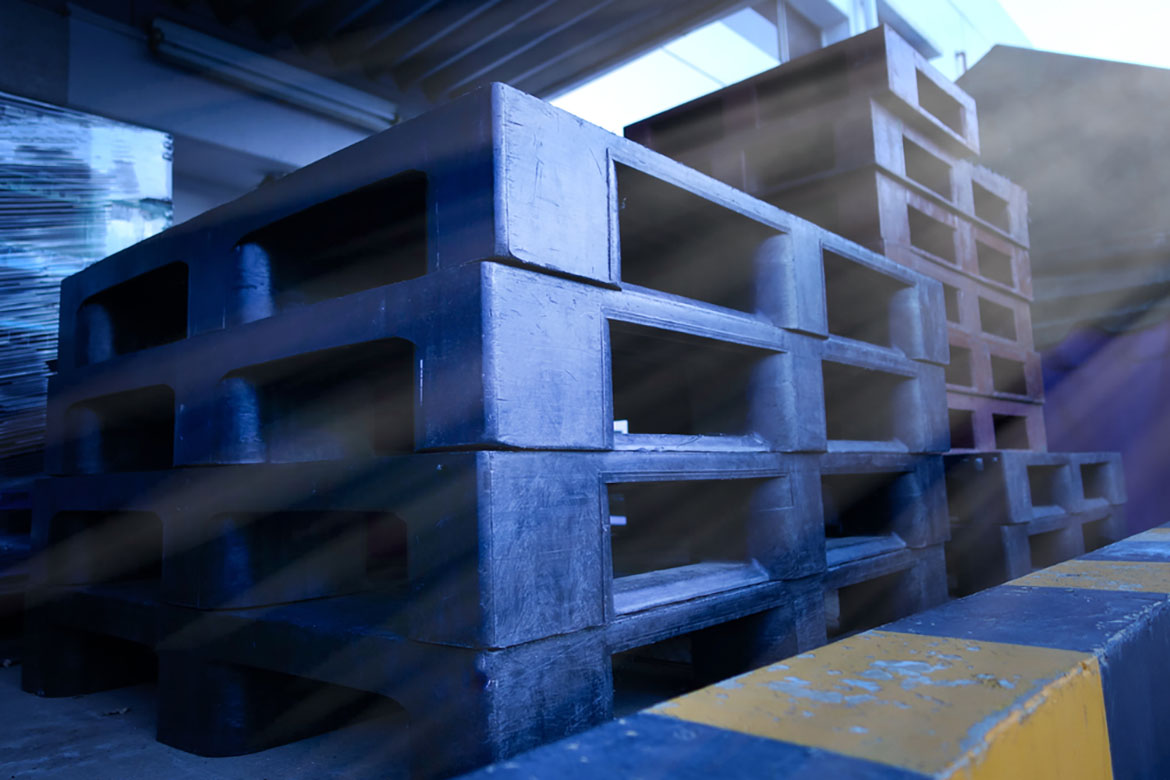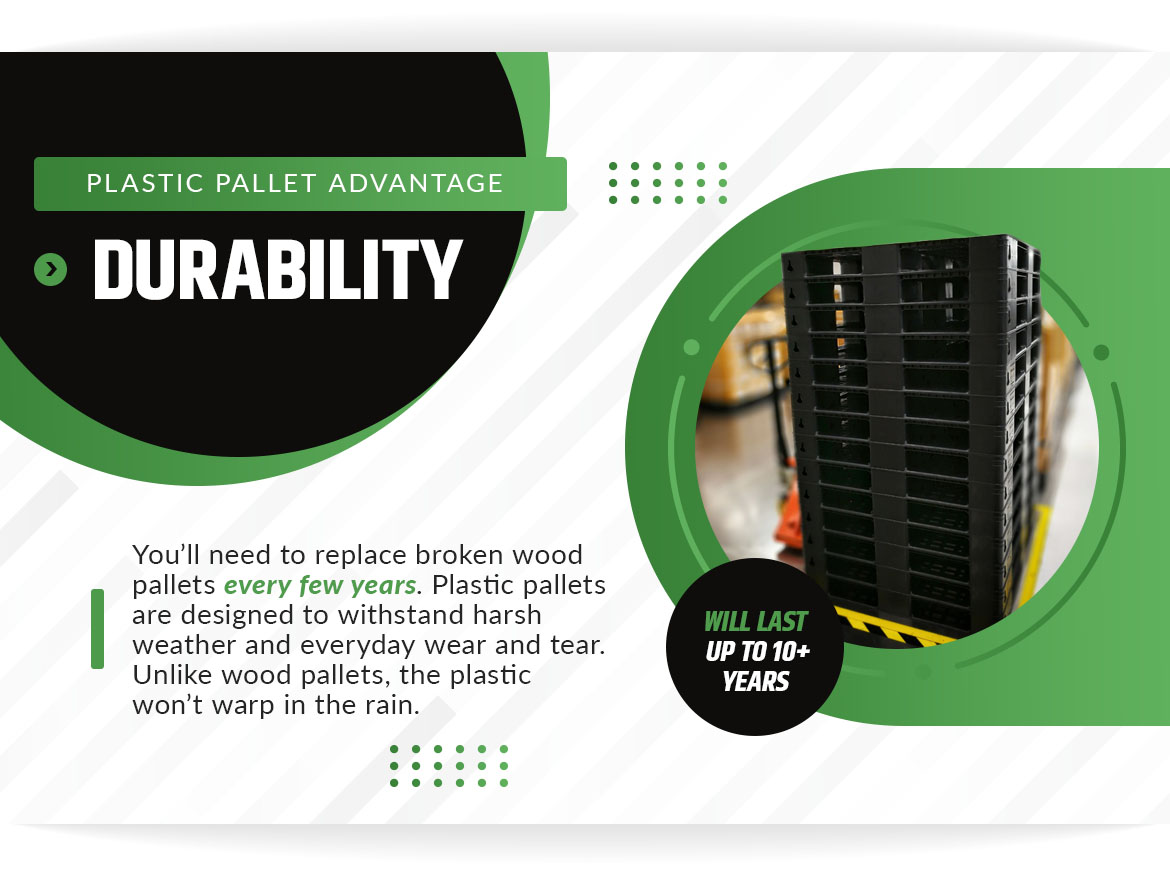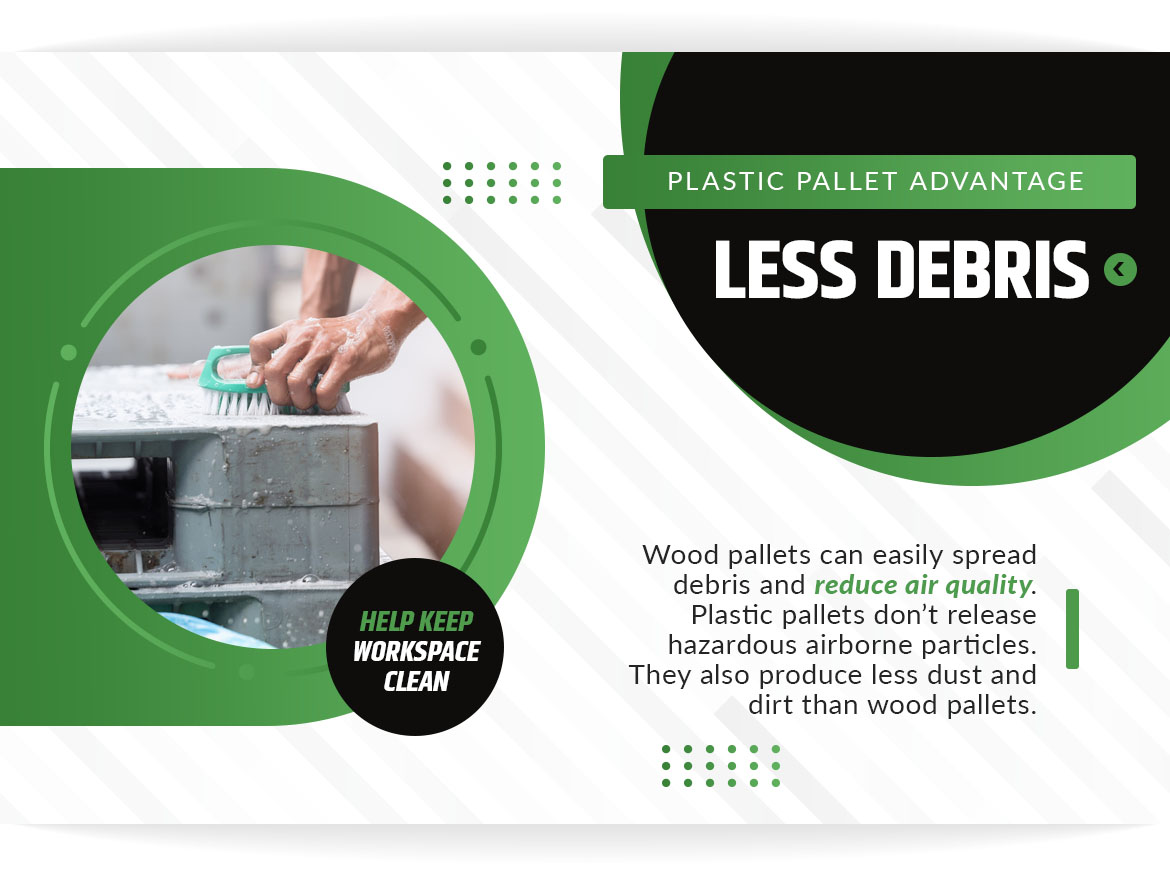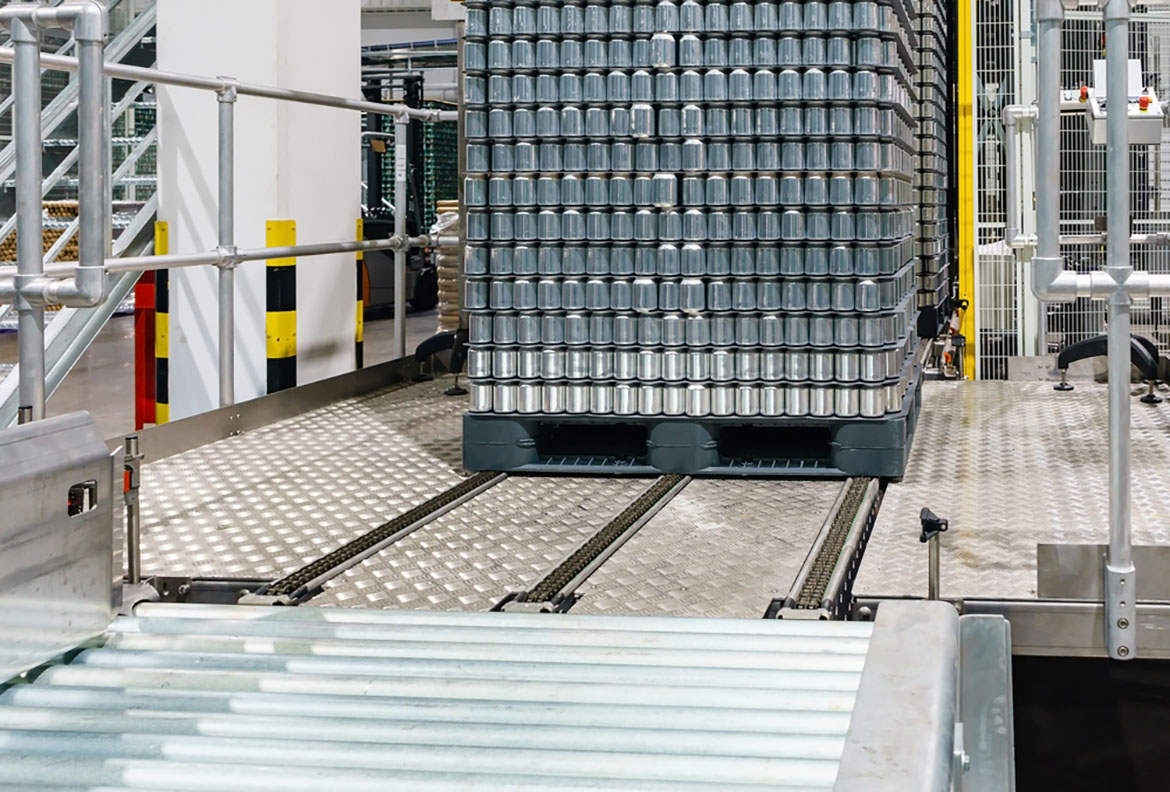Pallets make the world go round. They are used to ship and store all kinds of products in the supply chain. All pallets feature a horizontal surface with a superstructure attached to a bottom deck. They are designed to be used with a forklift or lift truck. The forks slide between the stringers, the columns that hold the bottom deck to the top deck. This is usually the safest and easiest way to move large volumes of cargo.
Pallets can either be made from wood, plastic, metal or corrugated paper. They come in a variety of sizes with the 48” x 40” size being the standard in North America. Each type of pallet is designed for a particular use. You may not have a choice in terms of what types of pallets you use, depending on your inventory. Wood pallets tend to be the most popular, but plastic pallets tend to be the better choice in some situations.
Learn more about the differences between plastic and wooden pallets and why so many companies prefer using the latter.
Plastic Pallets
Plastic pallets are made of high-density polyethylene (HDPE), a thermoplastic polymer made from petroleum. This is the same plastic that’s used in many food and beverage products, including milk bottles, water jugs and cleaning products like detergent and bleach.
Plastic pallets come in a range of sizes and styles. They are commonly used in the dairy, pharmaceutical and food processing industries.
Wood Pallets
Wood pallets are made with raw lumber that’s been turned into a series of boards. The boards are usually nailed together to make a pallet.
Wood pallets are incredibly easy and inexpensive to produce. They are typically treated with heat or special chemicals to prevent the spread of wood-borne pests and bacteria.
Around 90 percent of all pallets in circulation are made of wood. They are used in many different industries, including retail, produce and manufacturing.
You can choose between stringer wood pallets and block wood pallets. Stringers use three 2×4 boards to hold the top deck to the bottom deck, including one on either end and another in the middle. This leaves more space for the forks to move through the pallet, but stringer pallets can’t hold as much weight as block pallets.
Block pallets use nine 4×4-inch wood blocks to hold the top and bottom decks together. The added wood leaves less room for the forks, but these pallets can hold more weight.
Benefits of Using Plastic Pallets
Even though wood pallets tend to be cheaper than plastic pallets, they can cost you in other ways. Wood pallets aren’t designed for certain industries or storage environments.
If you are trying to choose between plastic and wood, look beyond the price tag and realize the advantages of using plastic pallets.
Reusability
If you want to save money and still enjoy the benefits of plastic pallets, you can always buy used to avoid paying more than necessary. Used pallets tend to be comparable in price compared to new wooden pallets. You can always resell your used plastic pallets online if you no longer need them and quickly make most of your money back. Reinvest whatever money you earn in your business.
Wooden pallets aren’t meant to be reused as often as plastic pallets. They often need to be repaired every year or so and will continue to degrade naturally over time, so you might not be able to sell your wooden pallets when the job is done.
Durability
You don’t have to worry about your plastic pallets breaking down. They are considered much more durable than wood pallets with the lifespan to prove it. Plastic pallets will last up to 10 years or more if you treat them well, while wooden pallets tend to fall apart after three to five years.
That means you’ll need to replace your broken wood pallets every few years, which will only add to your shipping costs. Once the pallet reaches its lifespan, you run the risk of shipping out your goods on a damaged or faulty pallet. You may want to consider taking it out of rotation even if it looks like it’s in good condition.
Plastic pallets are designed to withstand harsh weather, moisture and everyday wear and tear. Unlike wood pallets, the plastic won’t change shape or warp in the rain. Forklifts can also damage wood pallets if the driver tries to enter from the wrong angle. The forks can easily knock boards out of place or loosen the nails that bind the wood together. Plastic pallets can take a beating and then some without falling apart so you don’t have to worry about losing a pallet when you need it most.
Shop for New and Used Stack Racks Online
Lightweight
Shipping is routinely calculated by weight and volume. The less your shipments weigh, the more money you save over time. Plastic pallets can weigh as little to three to 15 pounds, with the latter being the most common. Meanwhile, wooden pallets tend to weigh around 50 pounds, which can lead to thousands of dollars in excess shipping costs over the years.
Your workers will also enjoy working with lighter pallets. They can easily lift and move them by hand when they are empty without hurting themselves in the process.
Cleaner Workspace
Wood pallets can easily spread debris in your workplace, including wood chips, dust and dirt, all of which can reduce air quality. Wood materials become dangerous when they are sanded or ground down. The grinding releases small particles in the air that can cause allergic respiratory symptoms, mucosal and non-allergic respiratory symptoms and even cancer.
Even if your facility isn’t manufacturing wood pallets onsite, metal and plastic containers can rub against your pallets, releasing these particles into the air.
Plastic pallets don’t release hazardous airborne particles, so your staff can breathe easy on the job. This will also help you keep your workspace clean. They produce less dust and dirt than wood pallets for a safer work environment.
Versatility
Wood pallets shouldn’t be used in cold storage environments or areas that are prone to moisture. They should only be used with dry goods and must be placed in a shipping container when traveling overseas.
Plastic pallets don’t face as many restrictions as wood pallets. They can be used in nearly every type of storage environment or facility. Since plastic pallets are waterproof, you can store them directly on a shipping vessel without using a shipping container to further reduce the cost.
If your company ships and stores different types of goods, you can use plastic pallets for all your orders without putting your equipment at risk.
Less Regulation
Wood pallets are regulated to stop the spread of wood-borne pests and bacteria. All wooden pallets traveling internationally must be treated according to these regulations. If you ship wood pallets to another country, they must be inspected by customs, which can delay the importing process. You will also need to present evidence that your pallets have been treated using either heat or insecticide. If your pallets don’t meet these requirements, they will be rejected and sent back to the return address.
Plastic pallets don’t need to be treated for pests or bacteria, so your goods won’t get held up in customs. They move on to their destination as soon as possible.
Increased Weight Capacity
All pallets come with a set weight capacity. It’s important to condense your packages when loading your pallets without going over the weight limit or stacking your containers too high.
Stringer wood pallets come with a rackable weight capacity of 2,500 lbs., a dynamic weight capacity of 2,200 lbs. to 2,500 lbs. and a static weight capacity of 2,500 lbs.
Block wood pallets come with a rackable weight capacity of 2,800 lbs., a dynamic weight capacity of 4,600 lbs. and a static weight capacity of 5,500 lbs.
Plastic pallets come with a rackable weight capacity of 2,800 lbs., a dynamic weight capacity of 5,000 lbs. and a static weight capacity of up to 30,000 lbs.
Every pound counts when you are trying to squeeze your products into as few loads and shipments as possible. The added weight capacity will help you consolidate your goods without putting your pallets at risk.
Sustainability
Many companies are in the process of lowering or eliminating their carbon footprint. Both wood and plastic pallets can damage the environment in different ways. Trees naturally remove carbon dioxide from the atmosphere and are essential in the fight against climate change. Wood pallet production uses 43 percent of hardwood and 15 percent of softwood produced in the U.S. They also tend to fall apart more easily, which only increases demand for lumber.
Plastic pallets are made using petroleum, a fossil fuel that contributes to climate change. Buying new plastic pallets only increases demand for fossil fuels that harm the environment. You can get around this by buying used plastic pallets so manufacturers don’t have to use any more oil.
Plastic pallets can also last for years on end if they are used properly so you don’t have to keep ordering more supplies.
Improved Tracking and Inventory Oversight
Many companies have started using automated warehouse management systems that track inventory and supplies in real time.
You can securely attach radio frequency identification (RFID) trackers to your plastic pallets so you always know where they are. Track your inventory and pallets to make sure they stay together as they make their way to the destination.
You can also attach barcodes to your plastic pallets and have your workers scan them as they move throughout the supply chain.
Wood pallets tend to be hard to track. They’re not as valuable as plastic pallets, so many companies don’t bother to track them. You may also have trouble attaching a label to the wood. Heat, sunlight and moisture can wear away at the label, leaving you without a way to track your inventory.
Your pallets are valuable inventory. Tracking them will help you avoid losing your equipment, especially when it’s traveling around the world.
Save Money with Used Commercial Racking Systems
Tips for Using Plastic Pallets
If you decide to utilize plastic pallets, choose a size based on where your goods are going. The 48” x 40” size is the standard in North America, but Europe and Asia tend to use the 1200cm x 1000mm pallet.
It’s best to store your pallets on stack racks. You can adjust the height of each row depending on the height of your merchandise. Leave enough space between the aisles so that your workers can easily retrieve products using a forklift. Keep the heaviest units on the bottom of the rack and check the weight capacity to avoid going over the limit.
Plastic pallets can also be used with automation. They can easily fit onto a commercial conveyor belt to help you quickly move your products. They won’t get damaged when you put them in stack racks that automatically spring your inventory forward and back, depending on how many units are on the shelf.
Consider using wire decking for pallet racks to make your shelves more secure. The wire mesh creates an even surface across the entire rack so you don’t have to worry about your pallets shifting or falling through the cracks.
Clean off your plastic pallets after each trip to keep your workspace as clean as possible. Mark each pallet with the name and address of your company so your business partners don’t mistake your pallets for their own.
Plastic pallets are sure to serve you well regardless of what kinds of products or services you provide. They are a valuable investment that will help your company save money over time.
Image Credits
NeelRong/Shutterstock.com
sarawut muensang/Shutterstock.com
Sorn340 Studio Images/Shutterstock.com
NavinTar/Shutterstock.com
Washdog/Shutterstock.com
THANISORN PANYA/Shutterstock.com
Sorn340 Studio Images/Shutterstock.com
Ratchat/Shutterstock.com
Fahroni/Shutterstock.com
Juan Enrique del Barrio/Shutterstock.com
